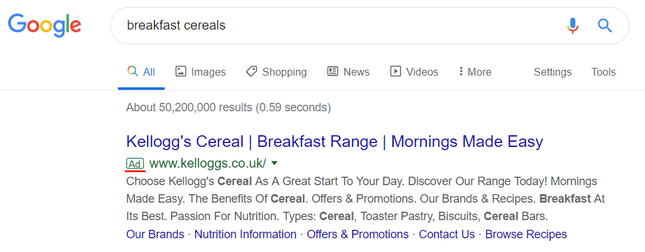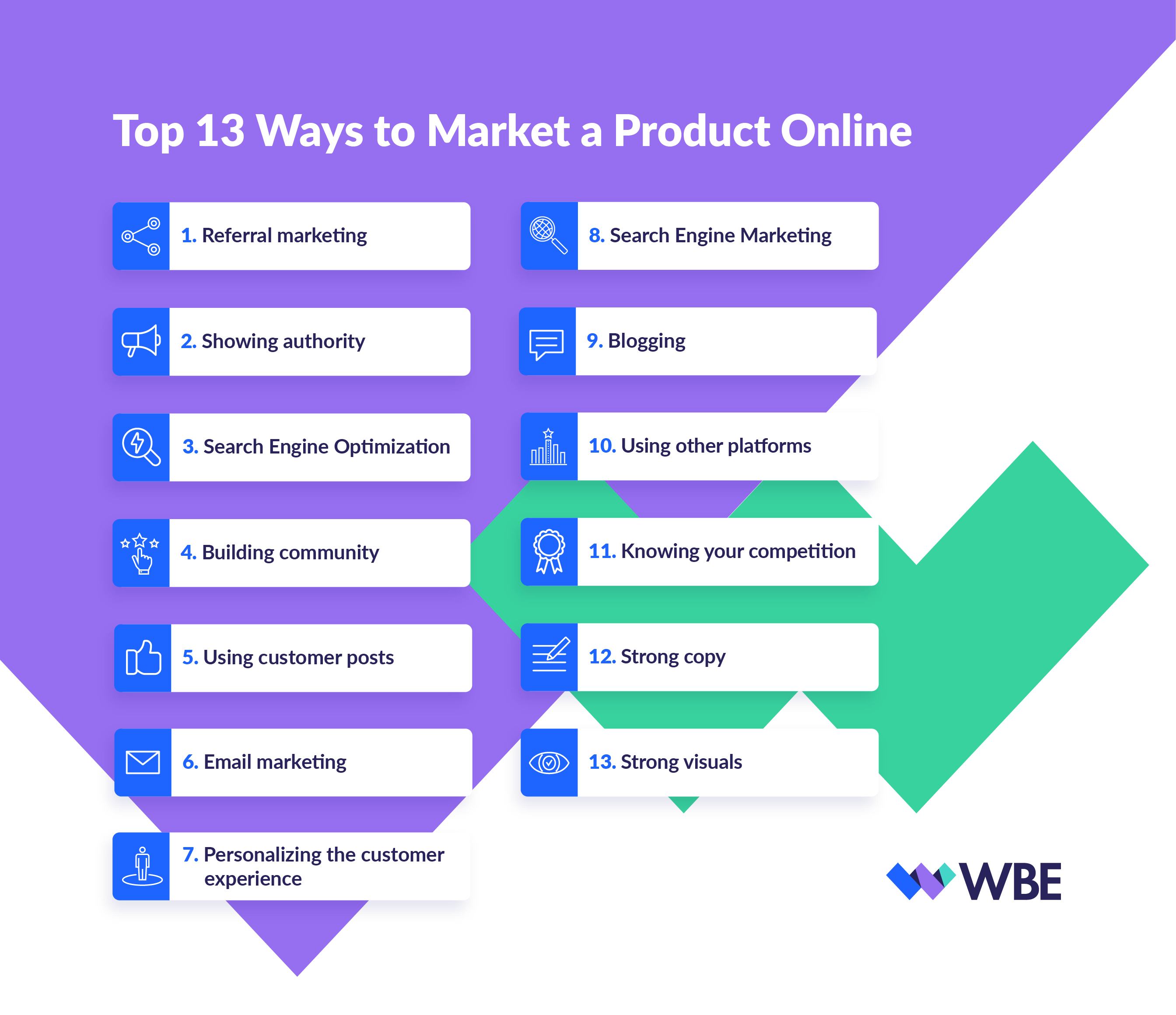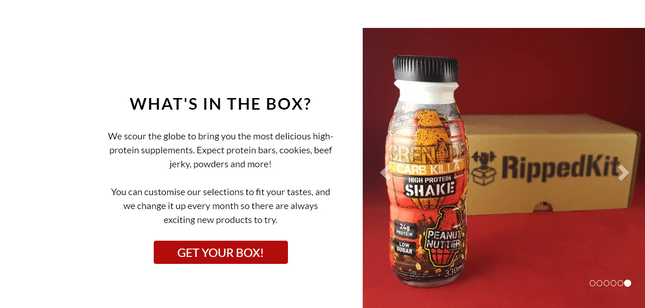How to Market a Product and Successfully Sell Online
If you click to purchase a product or service based on our independent recommendations and impartial reviews, we may receive a commission. Learn more
Anyone still getting used to business in the digital age has wondered how to market a product and attract customers to your online store. The good news is, you’ve already done the work, and have a product that you know will sell. At this point, it’s just a matter of getting it in front of the right audience – and we’ve compiled a list of the most effective techniques for doing just that.
Top 13 Ways to Market a Product Online
- Referral Marketing
- Showing authority
- Search Engine Optimization (SEO)
- Building community
- Using customer posts
- Email marketing
- Personalizing the customer experience
- Search Engine Marketing (SEM)
- Blogging
- Using other platforms
- Knowing your competition
- Strong copy
- Strong visuals
Don’t be scared off by some of the techier-sounding points. All of these strategies are beginner-friendly, and we’ve given each an Ease of Setup score out of 5, so you’ll know exactly what you’re getting into!
1. Referral Marketing
Referral marketing is the kind of word-of-mouth advertising you get when people tell their friends about your business. This is easily the most effective marketing method, because people are getting recommendations from sources they trust – you’d probably take a friend’s word over a Google search result. In fact, referral leads convert 30% better than leads generated from other marketing channels.
Referral marketing is even more powerful in the age of the internet, because one share on Facebook or repost on Instagram can reach so many people at once. While the best referral marketing – i.e., unprompted customer shares – is partly out of your control, you can encourage people to post about your products by providing special offers or discounts in return.
How to Sell Online – Our in-depth guide
2. Showing Authority
When people research a product, they want to find out whether or not they’re buying from a reliable source. Creating a professional website is a great opportunity to establish your business (and by association, your products) as high quality.
Luckily, there are a range of website building options that make it easy to put together a sleek site – and you won’t need any technical or coding knowledge to do it. Platforms like Shopify and BigCommerce allow you to set up ecommerce websites that you can sell your products on, in no time at all. We spoke to Francis Holmer, founder of RippedKit, about why he chose Shopify to help promote his business:
“It is a well-maintained platform that provides everything I need for website management, updates, pricing, order fulfilment, customer communication etc.”
There’s no shortage of great platforms to help you accomplish the same!
3. SEO
Once you’ve set up your stunning online store, the next step is to make sure potential customers can see it. SEO, or Search Engine Optimization, is the process of getting your site to rank higher on popular search engines like Google. You can better optimize your site in a number of ways, like choosing short and relevant page URLs, and making sure you title your pages with relevant search keywords.
Keywords are important, because if you want your product pages to rank highly in search results, you need to know what potential buyers are actually searching for. First, you can brainstorm a list of keywords relevant to your product that you think would be worthwhile to focus on. Then, you can use a free tool like Google Trends (or a paid tool with more in-depth capabilities) to find out how much search volume those phrases get per month, and choose your top keywords accordingly.
If you think SEO sounds a little intimidating, you’re not alone. In fact, an endless number of blogs have been created just to help people new to the SEO game. Some of these blogs are better than others, and we have a few favorites:
- Ahrefs Blog covers all the bases of SEO, from keyword research to link building, in a beginner-friendly way. It’s full of digestible tips and how-to guides, so you can read with speed and then get to work!
- Moz Blog you might think of SEO as a pretty dry topic to base an entire blog on, but Moz manages to write pieces as entertaining as they are informative.
- SemRush Blog writes easy-to-understand content that will help you get comfortable with all of the latest SEO lingo.
Simple SEO Tip – Learn about backlinks, and see what they can do for your site
How to Write Meta Descriptions – Learn how to effectively drive traffic to your site
Best Online Marketing Courses – Improve your digital marketing skills with one of these brilliant courses
4. Building Community
This strategy is successful for the same reason as referral marketing: people love to hear from each other. It’s one thing for you to rave about your own product, but it’s another (more lucrative) thing for customers to do it for you. And according to one study, customers spend 19% more after joining a company’s online community.
There are two effective ways to build up your digital customer community. You can set up a forum (or even just a comments section) on your brand’s website, and you can also set up a forum on one of your brand’s social media pages, like Facebook. By allowing people who shop for your products to come together and talk about them, you’re creating a digital home for customer reviews. This sense of community will encourage old buyers to come back, and new buyers will feel confident in their purchase after reading positive reviews.
5. Using Customer Posts
Once people have a voice to talk about your products online, you can let the resulting publicity speak for you. Reposting quotes and photos from customers, AKA User Generated Content (UGC) on your own social media pages is a great way to show that real people are enjoying your products. The resulting social proof makes a real difference – 92% of people will trust a recommendation from a peer, and 70% of people will trust a recommendation from someone they don’t even know.
Find out more
Learn How to Use Online Reviews to Market to Different Generations in our handy infographic!
6. Email Marketing
Email marketing is a powerful way to promote your product to a ton of interested customers at once. Especially since at least 99% of consumers check their email on a daily basis. You can use platforms like MailChimp to allow customers to subscribe to automated marketing emails from you and your business. These sign-ups happen through forms that you can integrate on your website.

You can use email marketing to help with abandoned cart recovery, too. You can automatically email people who have put items in their cart, but left the site before completing a purchase. Studies show this works – 50% of users who opened a cart abandonment email went on to complete the purchase.
Email marketing is also an excellent tool to let your customers know that they’re valued. Since you can tailor the content of your emails based on buying history and preferences, your customers will appreciate that you’re showing them products that are relevant to them. Which brings us to…
7. Personalizing the Customer Experience
Over all the other options available, buying customers have chosen your product – and you should show them that you appreciate it! In addition to tailored email marketing, there are a lot of small ways to show each buyer that you value them uniquely. You can allow customers to create profiles on your site, or even offer specific discounts based on buying history. Every bit of personalization counts – 88% of marketers say they’ve seen a measurable improvement in their business after implementing such tactics.
8. Search Engine Marketing (SEM)
SEM is basically the paid alternative to SEO, in which you’d pay to place an ad at the top of search results for certain keywords. SEM is the only option on this list that isn’t free, but it can be a worthy investment: SEM comes second only to SEO in terms of effectiveness, and it requires much less technical knowledge to implement. It’s also a fast way to give your brand and products a web presence, which is invaluable since digital ad spending surpassed TV for the first time in 2017, and we’re only getting more tech-obsessed.

9. Blogging
Blogging gets a 4/5 for ease of use, because most website builders and ecommerce platforms make it easy to set up a blog function on your site. But we can’t give blogging a 5/5, because while anyone can make a blog, not everyone can make an effective blog.
Useful, well-written content is what makes a blog that can actually drive sales. When you write great posts, other people will share and link to them, which increases your site’s legitimacy in the eyes of search engines. A great blog will improve your SEO and SEM efforts by improving the rankings of all of your pages, not just your blog posts. That means your product pages will be more visible in search results when customers are ready to buy from you.
Best Blogging Platforms – A ranking of the top ten
10. Using Other Platforms
Just as you should personalize the customer experience on your site, you should also know your customers well enough to know which social media sites they frequent. There’s no point running an ad campaign on Facebook if your target demographic is Instagram-obsessed teens. This is an example of working smarter, not harder – once you have your promo materials ready to go, it’s only a matter of knowing where to place them. Quick tip: you can’t go wrong by starting with YouTube, since 1.9 billion logged-in users visit the site every month!
11. Knowing Your Competition
It’s always a good idea to know what your competitors are doing right. But it’s also a great idea to know what they’re lacking, so that your product can be the solution that fills that space. You can figure out which customer base to focus on by identifying the needs that are not being addressed by your competitors. This is easier said than done, but it’s a worthy time investment that can help your brand become the authority in a new space.
12. Strong Copy
Once you’ve done all your research – and then some more research – you’ll be ready to tell your audience why they need your amazing product in their lives. Having that research base will instantly make your writing more relatable, but you should take it a step further by really investing in your copy.
We’ve given this a 3/5, because every brand is different. You might feel comfortable writing product descriptions yourself, or you might want to bring in a copywriter to turn a “good doughnut” into a “must-have breakfast sensation.”
How to Write a Call to Action – boost conversions with these expert tips
13. Strong Visuals
On a similar note, you can’t underestimate the value of great images. This is especially true of product images on ecommerce sites, because people want to see exactly what they’re ordering before they commit. If you have great products, then this is just a matter of showing it – and again, you can take these photos yourself or bring in an experienced photographer. Product videos are also an increasingly effective promo method. In fact, viewers are anywhere from 64-85% more likely to buy after watching a product video (you’ll probably want to bring in an experienced videographer for these, since they’re so high impact!).
Which Methods Should You Use?
All of the above methods are helpful for any business, but some will be more applicable to your product than others. If you’re wondering how to market a new product, then a concrete approach like SEM has the right amount of push. If you’re trying to promote a product with an established customer base, then you might try referral marketing to reach a wider audience. If you’re trying to appeal to existing customers, then email marketing is a great way to re-engage your audience.
The top three factors to consider when choosing how to promote a product are:
- The target customers
- The type of product
- The size of your business
If you’re stuck on a place to start, methods like blogging and showing authority are simple ways to boost any product’s reputation!

Final Thoughts
There are endless ways to market a product online, but we’ve chosen the 13 easiest and most effective strategies. Which one you choose will depend on the three factors above. To recap:
| Strategy | Ease of Setup/5 | Summary |
|---|---|---|
| Referral Marketing | 3 | Using word of mouth to increase awareness of your product. |
| Showing Authority | 5 | Establishing yourself as a quality product provider. |
| Search Engine Optimization (SEO) | 3 | Equipping your product pages to rank in Google search results. |
| Building Community | 5 | Providing a digital space for your customers to interact. |
| Using Customer Posts | 5 | Letting your customers' reviews speak for you. |
| Email Marketing | 4 | Frequently communicating with customers via (often automated) email. |
| Personalizing the Customer Experience | 5 | Showing that you value each customer's unique shopping needs. |
| Search Engine Marketing (SEM) | 4 | Paying for top-spot ads in search results. |
| Blogging | 4 | Generating unique written content. |
| Using Other Platforms | 4 | Knowing which social media platforms your customers frequent, and using them. |
| Knowing Your Competition | 3 | Knowing your competitors' weaknesses, so that you can become the best in those areas. |
| Strong Copy | 3 | Writing enticing product descriptions. |
| Strong Visuals | 4 | Creating stunning product photos and videos. |
Whether you’re ready to shell out for SEM or just want to spread the word through customer posts, it always helps to have confidence. You already have a strong product – now it’s time to brag. And if you have SEO tips or advice of your own, don’t hesitate to share with us in the comments!


1 comment